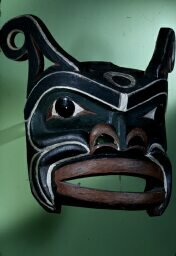Floor Maps
Download or Print |
Ground Floor1. The Museum Marketplace |
Download or Print |
Ground Floor1. The Museum Marketplace |
Jackie is a graduate of the University of Wisconsin-Milwaukee with a BA in Anthropology and Classical Civilization, and a MA in American History with a Certificate in Museum Studies. Her interests include American and local history with a special interest in Milwaukee WPA projects, especially the Milwaukee Handicraft Project. She has previously worked as a Conservation Assistant at the Milwaukee Art Museum and Exhibition Project Coordinator at the Milwaukee Public Museum.
The geographical regions of North America are diverse, and so too are the people who adapted to those environments. Tribes that shared a regional domain with access to many of the same resources and environmental constraints would often develop similar technology and artistic decoration. Regional boundaries only show general patterns of similarity; they are not static.
Walking was the most common way of moving, and personal possessions were limited largely to what the people could carry themselves.
 For the indigenous First Nations of Canada’s Pacific coast, masks are more than mere decoration or ceremonial props; they are part of a living tradition that connects people to their community, their collective past, their creator, their ancestors, their cosmology, and powerful elemental forces.
For the indigenous First Nations of Canada’s Pacific coast, masks are more than mere decoration or ceremonial props; they are part of a living tradition that connects people to their community, their collective past, their creator, their ancestors, their cosmology, and powerful elemental forces.The majority of the masks presented here were made by Kwakiutl[1] (now known as Kwakwak
Although the Plains Indians had no written language in which to record their history, they did have a long tradition of preserving oral histories pictorially. For centuries, Plains Indian men kept historical records of their tribes, first with petroglyphs and pictographs on rock walls, and then painted on buffalo hides.
Aztalan was first discovered by Europeans in the fall of 1835 by early Wisconsin Territory settler Timothy Johnson of Watertown. Upon hearing stories of the site, Judge Nathaniel Hyer, a Milwaukee settler, visited. His description, the first at-length published account of Aztalan, appeared in the Milwaukee Advertiser, Volume One, Number 29 on Saturday, February 25th, 1837. In this account, Judge Hyer also produced the first rudimentary map of the site.
When the Creator was finished making the earth, he gave responsibility for the four quarters of the Earth to four powerful beings, or mani'towuk. Their duty was to take care of these regions. These beings caused the winds to blow from different directions, and are responsible for other phenomena as well. Winter is the result of a game of bowl and dice between the mani'towuk of the north and the mani'towuk of the south.